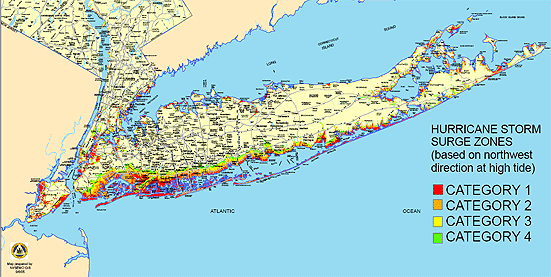Home » Maps » Long Island looding Zones

Image via Nassau County Office of Emergency Management & NYSEMO GIS.
The largest flood zones on the Island are found on the south shore of Nassau and Suffolk Counties, with Fire Island being the first area to flood. The areas that are most susceptible to the highest storm surges are Amityville Harbor, Atlantic Beach, Long Beach, South Oyster Bay, Middle Bay, East Bay, and Montauk Point. Due to the positioning and low elevation of the North and South Forks, both are also considered vulnerable to flooding in the event of another strong hurricane. Another factor that contributes to the severity of a storm on parts of Long Island is the point at which the storm strikes during the tide cycle. If a storm occurs at high tide, it can have a much more devastating impact than it would if the storm hit at low tide.
To stay safe in the event of a flood or predicted storm surge, it is integral to know your emergency evacuation routes for your area, either in Nassau County or Suffolk County, and to also be able to locate the hurricane shelter nearest you. Also, if a severe storm is in the forecast, prepare ahead of time by putting together a bag of important items, such as water, non-perishable food, medications, clothing, important documents, flashlights and batteries, and a battery-powered or hand-crank radio.
The addition of more properties to the legal flood zone area by FEMA has raised the ire of many homeowners, since flood insurance is mandatory if you live in a high-risk area and have a mortgage from a federally regulated or insured lender. Many also believe that this affects the housing market, as people are less likely to purchase a home in a flood zone due to the high cost of flood insurance – regardless of if the house has ever actually been in a flood.
Additional Resources for Sports on Long Island